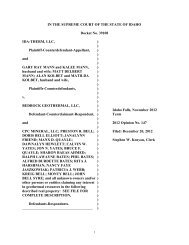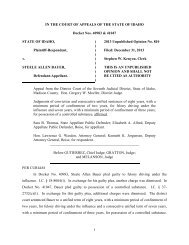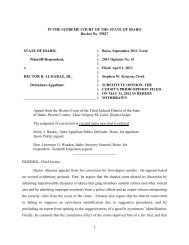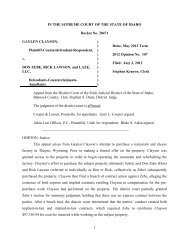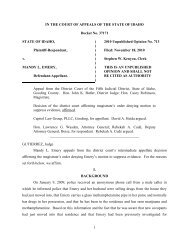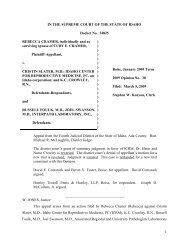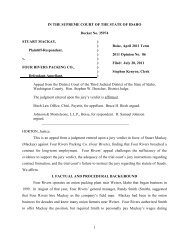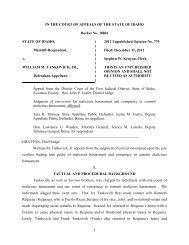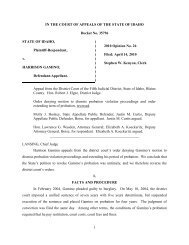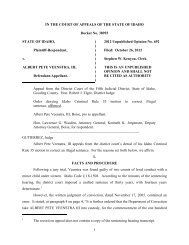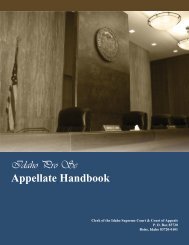GUTIERREZ, J - Idaho State Judiciary
GUTIERREZ, J - Idaho State Judiciary
GUTIERREZ, J - Idaho State Judiciary
You also want an ePaper? Increase the reach of your titles
YUMPU automatically turns print PDFs into web optimized ePapers that Google loves.
IN THE COURT OF APPEALS OF THE STATE OF IDAHO<br />
Docket No. 34658<br />
STATE OF IDAHO,<br />
Plaintiff-Respondent,<br />
v.<br />
ABIGAIL M. SWINDLE,<br />
Defendant-Appellant.<br />
)<br />
)<br />
)<br />
)<br />
)<br />
)<br />
)<br />
)<br />
)<br />
)<br />
2009 Opinion No. 47<br />
Filed: June 22, 2009<br />
Stephen W. Kenyon, Clerk<br />
Appeal from the District Court of the First Judicial District, <strong>State</strong> of <strong>Idaho</strong>,<br />
Kootenai County. Hon. Lansing L. Haynes, District Judge.<br />
Judgment of conviction for possession of a controlled substance, affirmed.<br />
Molly J. Huskey, <strong>State</strong> Appellate Public Defender; Heather M. Carlson, Deputy<br />
Appellate Public Defender, Boise, for appellant.<br />
Hon. Lawrence G. Wasden, Attorney General; Jessica M. Lorello, Deputy<br />
Attorney General, Boise, for respondent.<br />
______________________________________________<br />
<strong>GUTIERREZ</strong>, Judge<br />
Abigail M. Swindle appeals from her judgment of conviction entered upon her<br />
conditional guilty plea to possession of a controlled substance. Specifically, Swindle challenges<br />
the denial of her motion to suppress evidence. We affirm.<br />
I.<br />
FACTS AND PROCEDURE<br />
The following facts were found by the district court after conducting an evidentiary<br />
hearing on Swindle‟s motion to suppress:<br />
On March 3, 2007, [Swindle] was a visitor at a mobile home owned by<br />
Kristine Bear in Post Falls, <strong>Idaho</strong>. That day Kootenai County Sheriff‟s Deputies<br />
Patrick Meehan and Charles Sciortino, acting on separate tips by two identified<br />
neighbors that drug activities were occurring in the mobile home, went to that<br />
home and were invited in by Kristine Bear. The deputies explained why they<br />
were there, and Ms. Bear gave her consent for the deputies to look around.<br />
1
Deputy Sciortino asked if there were other people in the residence, and Bear said<br />
there was one other person in the back room.<br />
Deputy Sciortino went to the back bedroom where he saw the defendant.<br />
He asked the defendant if there was anyone else in the residence, and she replied<br />
that there was not. Deputy Sciortino brought the defendant toward the living<br />
room, and in doing so discovered a woman hiding in another bedroom. This other<br />
woman gave Deputy Sciortino what turned out to be a false name and had a<br />
warrant out for her arrest. The deputy took both the defendant and the other<br />
woman to the living room where Deputy Meehan, Ms. Bear, and her minor son<br />
were located. Deputy Sciortino then received verbal consent from Ms. Bear to<br />
search the residence for drugs. While in the living room, the defendant asked to<br />
go into the bathroom to get a band-aid for her finger. Deputy Sciortino saw that<br />
she already had a bandage on the indicated finger. Deputy Sciortino denied this<br />
request and said to wait a few minutes as they would be done soon.<br />
While Deputy Sciortino searched the residence, Deputy Meehan could not<br />
recall if he returned the defendant‟s identification. Deputy Sciortino found a<br />
bindle of what is alleged to be methamphetamine in the bathroom; this bindle<br />
appeared to have been recently used to ingest suspected drugs. Deputy Sciortino<br />
returned to the living room where he advised everyone present of their Miranda 1<br />
rights. All of the individuals indicated they understood their rights.<br />
Deputy Sciortino told all assembled about finding the bindle in the<br />
bathroom, and asked to whom it belonged. All answered to the effect, “Not me.”<br />
Deputy Sciortino then said that somebody was going to admit to the bindle or<br />
everybody was going to be going to jail. He also advised that somebody should<br />
be honest and admit the bindle belonged to that person. He further advised that at<br />
jail he would be performing drug tests on the arrested persons, but all that could<br />
be avoided if someone is honest; otherwise everyone will go (to jail).<br />
At that point the defendant said, “I‟ll take it. It doesn‟t matter, I‟m not<br />
letting her (presumably Ms. Bear) with kids go to jail.” Deputy Sciortino<br />
admonished the defendant a few times not to make a false admission, but the<br />
defendant persisted that she would take responsibility for the bindle.<br />
The defendant admitted last using methamphetamine about a week prior,<br />
and was then arrested. A search incident to arrest revealed methamphetamine and<br />
seven pipes in her pockets and in her bra.<br />
Swindle was charged with possession of a controlled substance, methamphetamine, <strong>Idaho</strong><br />
Code § 37-2732(c)(1), and possession of drug paraphernalia with intent to use, I.C. § 37-<br />
2734A(1). She filed a motion to suppress her statements and the evidence seized from her<br />
person after her arrest, contending she was illegally seized and her statements and the evidence<br />
seized after her arrest were the “fruit” of her illegal detention. Following a hearing, the district<br />
court denied the motion, and Swindle entered a conditional guilty plea to possession of a<br />
1<br />
Miranda v. Arizona, 384 U.S. 436 (1966).<br />
2
controlled substance, reserving her right to appeal the district court‟s denial of her motion to<br />
suppress.<br />
II.<br />
ANALYSIS<br />
Swindle argues that the district court erred in denying her motion to suppress because the<br />
officers did not have reasonable articulable suspicion that she was involved in criminal activity<br />
when they detained her.<br />
The standard of review of a suppression motion is bifurcated. When a decision on a<br />
motion to suppress is challenged, we accept the trial court‟s findings of fact which are supported<br />
by substantial evidence, but we freely review the application of constitutional principles to the<br />
facts as found. <strong>State</strong> v. Atkinson, 128 <strong>Idaho</strong> 559, 561, 916 P.2d 1284, 1286 (Ct. App. 1996). At<br />
a suppression hearing, the power to assess the credibility of witnesses, resolve factual conflicts,<br />
weigh evidence, and draw factual inferences is vested in the trial court. <strong>State</strong> v. Valdez-Molina,<br />
127 <strong>Idaho</strong> 102, 106, 897 P.2d 993, 997 (1995); <strong>State</strong> v. Schevers, 132 <strong>Idaho</strong> 786, 789, 979 P.2d<br />
659, 662 (Ct. App. 1999).<br />
The Fourth Amendment to the United <strong>State</strong>s Constitution guarantees every citizen the<br />
right to be free from unreasonable searches and seizures. <strong>State</strong> v. Ramirez, 145 <strong>Idaho</strong> 886, 888,<br />
187 P.3d 1261, 1263 (Ct. App. 2008); <strong>State</strong> v. Salois, 144 <strong>Idaho</strong> 344, 347, 160 P.3d 1279, 1282<br />
(Ct. App. 2007); <strong>State</strong> v. Cerino, 141 <strong>Idaho</strong> 736, 737, 117 P.3d 876, 877 (Ct. App. 2005). Its<br />
purpose is “to impose a standard of „reasonableness‟ upon the exercise of discretion by<br />
government officials, including law enforcement agents, in order to „safeguard the privacy and<br />
security of individuals against arbitrary invasions.‟” Delaware v. Prouse, 440 U.S. 648, 653-54<br />
(1979) (quoting Marshall v. Barlows, Inc., 436 U.S. 307, 312 (1978)).<br />
Under the Fourth Amendment, an investigative detention is permissible if it is based upon<br />
specific articulable facts which justify suspicion that the detained person is, has been, or is about<br />
to be engaged in criminal activity. Terry v. Ohio, 392 U.S. 1, 26 (1968); <strong>State</strong> v. Sheldon, 139<br />
<strong>Idaho</strong> 980, 983, 88 P.3d 1220, 1223 (Ct. App. 2003). The quantity and quality of information<br />
necessary to create reasonable suspicion for such a “Terry stop” is less than that necessary to<br />
establish probable cause, Alabama v. White, 496 U.S. 325, 330 (1990); <strong>State</strong> v. Bishop, 146<br />
<strong>Idaho</strong> 804, 811, 203 P.3d 1203, 1210 (2009), but must be more than a mere hunch or<br />
unparticularized suspicion. Terry, 392 U.S. at 27. Reasonable suspicion must be based on<br />
3
specific, articulable facts considered with objective and reasonable inferences that form a basis<br />
for particularized suspicion. Sheldon, 139 <strong>Idaho</strong> at 983-84, 88 P.3d at 1223-24. Particularized<br />
suspicion consists of two elements: (1) the assessment must be based on a totality of the<br />
circumstances, and (2) the assessment must yield a particularized suspicion that the particular<br />
individual being stopped is engaged in wrongdoing. See id. at 983, 88 P.3d at 1223. An officer<br />
may draw reasonable inferences from the facts in his or her possession, and those inferences may<br />
be drawn from the officer‟s experience and law enforcement training. <strong>State</strong> v. Montague, 114<br />
<strong>Idaho</strong> 319, 321, 756 P.2d 1083, 1085 (Ct. App. 1988).<br />
In denying Swindle‟s motion to dismiss, the district court ruled that while Swindle had<br />
been detained in the residence after she was located by the deputy in the back bedroom, the<br />
detention was reasonable. The court based its ruling on two grounds: (1) that the deputies had<br />
reasonable, articulable suspicion that Swindle was engaged in criminal activity since she was<br />
found in a residence suspected of being the scene of drug activity, she had lied about the<br />
presence of another woman in the residence, and she had “nervously” requested to retrieve a<br />
band-aid from the bathroom for a finger that was already bandaged, and (2) the officers‟<br />
prerogative to detain persons found inside a residence that they are legally searching.<br />
Assuming, without deciding, that Swindle was detained immediately after the officer<br />
located her in the bedroom, we conclude the officer possessed reasonable articulable suspicion<br />
for the detention. Specifically, we conclude that the officers possessed the requisite suspicion<br />
that, at the least, Swindle was acting in violation of I.C. § 37-2732(d) which states that it is a<br />
misdemeanor offense “for any person to be present at or on premises of any place where he<br />
knows illegal controlled substances are being manufactured or cultivated, or are being held for<br />
distribution, transportation, delivery, administration, use, or to be given away.”<br />
Deputy Meehan testified that he and Deputy Sciortino had initially gone to Bear‟s<br />
residence after Deputy Meehan was “stopped” by another resident of the trailer park who<br />
“informed [him] that he felt there was drug activity going on in [Bear‟s trailer] and he wanted<br />
law enforcement to „do something about it.‟” Specifically, Deputy Sciortino testified that the<br />
neighbor was<br />
very articulate in explaining why he thought people were using or selling drugs<br />
within the trailer. He said he was a recovering methamphetamine addict himself.<br />
He also pointed to an event that happened that prior morning at about 4 a.m. when<br />
persons mistakenly knocked on his door asking for drugs. And upon speaking<br />
4
with him I found him to be very credible. And the way that he explained and<br />
articulated the happenings and goings on of the trailer next to him gave me<br />
reasonable suspicion to believe that the persons within that trailer were either<br />
using, selling, or possessing illegal drugs.<br />
When the officers first arrived at Bear‟s residence, Deputy Meehan testified that they were then<br />
approached by another neighbor “who told us the same thing that they felt there was drug<br />
activity going on there, but there was no one at home at the time.” The neighbor then agreed to<br />
call the officers as soon as he saw the residents come home, which he did, approximately one<br />
and one-half hours later, telling the officers that three individuals had arrived at the trailer in a<br />
vehicle. Neither neighbor provided a description matching that of Swindle as someone they<br />
believed to be involved in the drug activities in the residence.<br />
An informant‟s tip regarding suspected criminal activity may give rise to reasonable<br />
suspicion when it would “warrant a man of reasonable caution in the belief that a stop was<br />
appropriate.” White, 496 U.S. at 329; Bishop, 146 <strong>Idaho</strong> at 811, 203 P.3d at 1210. Whether a tip<br />
amounts to reasonable suspicion depends on the totality of the circumstances including the<br />
substance, source, and reliability of the information provided. See White, 496 U.S. at 328-29<br />
(noting that “an informant‟s „veracity,‟ „reliability,‟ and „basis of knowledge‟” are highly<br />
relevant factors in determining whether reasonable suspicion exists). In other words, a tip must<br />
possess adequate indicia of reliability in order to justify a Terry stop. Adams v. Williams, 407<br />
U.S. 143, 147 (1972); Bishop, 146 <strong>Idaho</strong> at 811-12, 203 P.3d at 1210-11. The more reliable the<br />
tip, the less information is required to establish reasonable suspicion. White, 496 U.S. at 330;<br />
Bishop, 146 <strong>Idaho</strong> at 812, 203 P.3d at 1211. Factors indicative of reliability include whether the<br />
informant reveals his or her identity and the basis of his or her knowledge, whether the location<br />
of the informant is known, whether the information was based on first-hand observations of<br />
events as they were occurring, whether the information the informant provided was subject to<br />
immediate confirmation or corroboration by police, whether the informant has previously<br />
provided reliable information, whether the informant provides predictive information, and<br />
whether the informant could be held criminally liable if the report were discovered to be false.<br />
White, 496 U.S. at 331-32; Williams, 407 U.S. at 146-47; Bishop, 146 <strong>Idaho</strong> at 812, 203 P.3d at<br />
1211; <strong>State</strong> v. Larson, 135 <strong>Idaho</strong> 99, 101-02, 15 P.3d 334, 336-37 (Ct. App. 2000). If a tip lacks<br />
adequate indicia of reliability, police generally must engage in further investigation before<br />
conducting a Terry stop. Williams, 407 U.S. at 147; Bishop, 146 <strong>Idaho</strong> at 812, 203 P.3d at 1211.<br />
5
Whether a tip that merely provides a description of a suspect and alleges that he or she<br />
committed a crime amounts to reasonable suspicion depends on whether the tip was anonymous.<br />
See Florida v. J.L., 529 U.S. 266, 271-72 (2000); Bishop, 146 <strong>Idaho</strong> at 812, 203 P.3d at 1211.<br />
See also <strong>State</strong> v. Van Dorne, 139 <strong>Idaho</strong> 961, 965, 88 P.3d 780, 784 (Ct. App. 2004). When such<br />
a tip is received from an anonymous informant, the tip generally will not give rise to reasonable<br />
suspicion. See J.L., 529 U.S. at 271-72 (concluding that a tip that a young man was carrying a<br />
gun did not give rise to reasonable suspicion because the anonymous informant merely alleged<br />
that the man committed a crime and provided a description of the suspect). On the other hand,<br />
when such a tip is received from a known citizen-informant, the tip is generally sufficient to<br />
establish reasonable suspicion. Van Dorne, 139 <strong>Idaho</strong> at 965, 88 P.3d at 784 (concluding that a<br />
known citizen-informant‟s tip indicating that the suspect was likely intoxicated and describing<br />
the suspect‟s vehicle provided police with reasonable suspicion to conduct a stop). Tips made by<br />
known citizen-informants are presumed reliable because the informant‟s reputation can be<br />
assessed and, if the informant is untruthful, he or she may be subject to criminal liability for<br />
making a false report. Bishop, 146 <strong>Idaho</strong> at 812, 203 P.3d at 1211; Van Dorne, 139 <strong>Idaho</strong> at 965,<br />
88 P.3d at 784. Accordingly, independent police verification of such tips is generally not<br />
necessary. Id. See also Williams, 407 U.S. at 146-47. Still, under the totality of the<br />
circumstances analysis, the content of the tip and the informant‟s basis of knowledge remain<br />
relevant in determining whether the tip gave rise to reasonable suspicion. Bishop, 146 <strong>Idaho</strong> at<br />
812, 203 P.3d at 1211. Personal observation by an informant is one of the strongest possible<br />
indications of a basis of knowledge. <strong>State</strong> v. Alexander, 138 <strong>Idaho</strong> 18, 23, 56 P.3d 780, 785 (Ct.<br />
App. 2002).<br />
We conclude that the officers possessed reasonable articulable suspicion that Swindle<br />
was at least involved in frequenting the scene of drug activity given her presence in the house<br />
that two neighbors had told the police they suspected was the site of drug activities. Both<br />
neighbors independently alerted authorities of their suspicions (arising from the neighbors‟<br />
personal observations) regarding drug activity. Because the identities of both individuals who<br />
reported to the police their suspicions regarding drug activity at Bear‟s residence were known,<br />
and because their reports were based upon personal observation, the tips are presumably reliable.<br />
Additionally, each tip tended to corroborate the other. Because the officers had reasonable<br />
suspicion that persons within the trailer were involved in illegal drug activity, it was not<br />
6
necessary that the neighbors‟ tips particularly implicated Swindle. It was enough to constitute<br />
reasonable suspicion to detain Swindle based on the neighbors‟ description to the officers of their<br />
suspicions of drug activity occurring at the residence (with one neighbor describing an incident<br />
that had occurred the prior morning) and that Swindle was found in the residence.<br />
Thus, because the detention was justified, it did not taint Swindle‟s statements made<br />
during the detention, nor did it taint the discovery of methamphetamine and paraphernalia<br />
following her arrest which was conducted with probable cause based on her statements admitting<br />
ownership of the methamphetamine. Therefore, we conclude the district court properly denied<br />
the motion to suppress, and we affirm Swindle‟s judgment of conviction.<br />
Chief Judge LANSING and Judge PERRY CONCUR.<br />
7



